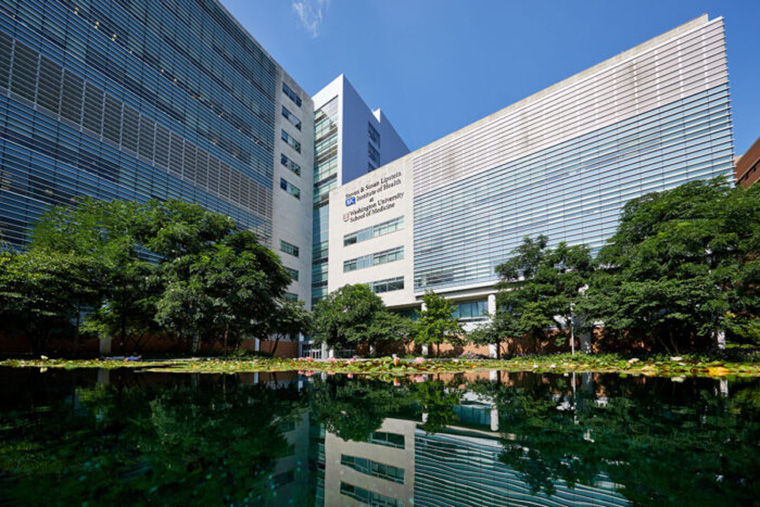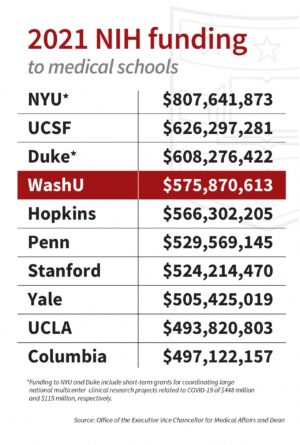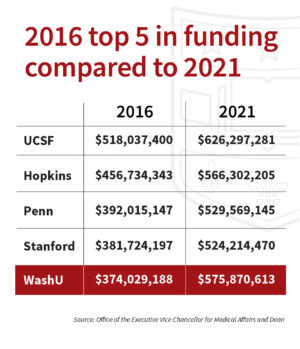
Researchers at Washington University School of Medicine in St. Louis were awarded $575.8 million in funding from the National Institutes of Health (NIH) in federal fiscal year 2021, according to the School of Medicine's 2021 State of the School Report, an increase of nearly $88 million over FFY2020. This is an all-time high for the school and the sixth consecutive year of growth in NIH grant awards.
Research grants to the School of Medicine from all sources - including foundations, donors and government agencies such as the Department of Defense and the Centers for Disease Control and Prevention - totaled nearly $750 million in our FY2021. Together with increased institutional support, the total annual investment in research has reached well over $1 billion.

"These impressive numbers are a reflection of the remarkable depth and breadth of our faculty here at the School of Medicine," said David H. Perlmutter, MD, the George and Carol Bauer Endowed Dean of the School of Medicine, executive vice chancellor for medical affairs, and the Spencer T. and Ann W. Olin Distinguished Professor. "Our goal is not to get grants per se. Our goal is advancing science. Our goal is curing diseases through our discovery capabilities, and these discoveries lead to new therapies and innovations in patient care."
Since 2016, NIH funding has grown by more than $200 million, an increase of 54% that corresponds to a compound annual growth rate of over 9%. "It is so extraordinary to see that with these numbers we have surpassed other exceptional medical research institutions such as Stanford, Johns Hopkins, and the University of Pennsylvania, and we have even closed what once seemed a formidable gap between us and the perennial No. 1 in NIH funding, the University of California at San Francisco.

"Washington University School of Medicine has been investing in research for decades - long before I had the opportunity to come as dean - and that has led to a history of groundbreaking publications and successful NIH funding," he went on. "We continue to build on that today through the leadership of the Executive Faculty of WashU and the power of its shared governance model. Every department head has worked to figure out ways to invest more in the research and clinical programs of their departments, to bring in new recruits and explore new research areas. We also benefited from the BJC Investigators program, which has brought six brilliant leaders in science to join the School of Medicine faculty, and we are working on bringing in four more BJC Investigators in the coming years.
"NIH funding is an objective measure of scientific competitiveness because NIH grants are among the most desirable and undergo the most rigorous peer review," Perlmutter noted. "We, and many of our peer institutions, consider it the most useful in setting strategic goals. NIH data is validated and verifiable, compared to many popular ranking metrics such as U.S. News, which are often opaque, less reliable, and less objective. We also care about NIH funding because it is not just the gold standard, it also provides partial funding for facilities and infrastructure that supports the research."
In addition to the dramatic growth in NIH support, the School of Medicine's 2021 State of the School Report noted other important metrics of growth and success over the past five years, including: growth in grants from other funding agencies, foundations and industry; major increases in scholarships and curriculum modernization; an increase in the number and diversity of medical school faculty; an increase in clinical activity in terms of patient visits and expansion in the number of staff to support that care; and substantial new investments in research and ambulatory clinic space as well as research and clinical programmatic initiatives. In total, the number of medical school faculty has increased 29% since 2016, and patient visits have increased by 51% during that same time period.
"I have been so impressed with the way our faculty and staff have risen to and performed at such a high level in the face of the challenges and disruptions of the COVID-19 pandemic," Perlmutter said. "The commitment of faculty and staff to our missions has been breathtaking: caring for patients to the highest standards today, while also doing the research that will allow us to enhance that care in the future."

Underpinning this schoolwide growth and success is what Perlmutter likes to call the "virtuous cycle" of academic medicine. "We invest in education and research to bring improvements to clinical care, better outcomes for patients and better health for the community. Our clinicians identify important areas for study. This culture of academic improvement is also a draw for more patient referrals and clinical research studies that distinguish what we do as a clinical provider," Perlmutter said. "That is the paradigm for success in terms of what we want to do for St. Louis and the region. Yes, we're doing the best we can to take care of patients today, but we aspire to do even more - we are compelled to do even more."
Going forward, Perlmutter sees a bright future for the School of Medicine, with an ever-growing capacity to contribute to the betterment of human health and welfare. "We are having a positive impact in so many ways here at WashU," said Perlmutter. "We are home to great talent and are succeeding in attracting new recruits as well. It is inspiring to see how our strategic plans have led to growth in all of our missions, research, education and clinical care. Looking to the future, our primary goals are: How do we improve health? How do we improve the economy in our community? Those might seem like daunting challenges, but by any of the metrics we look at, this medical school and this university are poised to deliver on those challenges."






